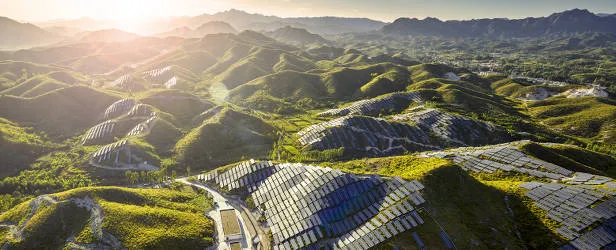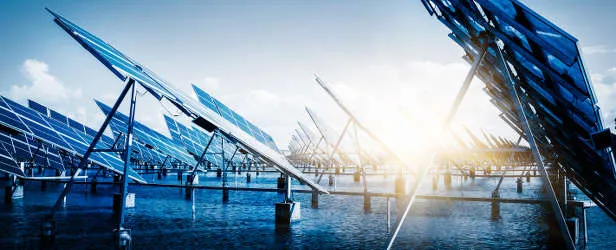September 05, 2019 | Podcast
Solar PV: Generating a brighter energy future
Transcript:
Transcript:
NARRATOR 1 Welcome to the DNV GL Talks Energy podcast series. Electrification, rise of renewables and new technologies - supported by more data and IT systems, are transforming the power system. Join us each week as we discuss these changes with guests from around the industry.
Transcript:
NARRATOR 2 Hello, you’re listening to ‘Face the Facts’, the new current affairs podcast from DNV GL Talks Energy, where the world’s leading energy experts share their insights on the most important global news stories about the energy transition.
Despite the challenges that faced large-scale solar deployment several years ago – mostly due to the need for a more ambitious price target – new research has found that the market is going from strength to strength, with global solar installations set to reach a record high of 114.5 gigawatts in 2019, up 17.5 per cent on 2018.
And, while decreased cost is making solar energy a competitive and viable choice for many around the world, new technologies are continuing to change the energy ecosystem and push the boundaries of renewables. In this episode, Dana Olson, Global Solar Segment Leader at DNV GL, explores the coming of age in solar power, the benefits already being seen and how advancements in technology are pushing it towards an even brighter future.
Transcript:
DANA OLSON Over the last several years, there has been a troubling outlook for solar energy at scale. A study from Lawrence Berkeley National Lab in 2012 predicted the decreasing value of solar energy with increasing deployment. This is due to the fact that all the solar generation has been put onto the grid at the same time of day, resulting in decreasing value of the electricity delivered.
A follow-up study in 2016, in Nature Energy, reiterated this decreasing value and projected solar costs would need to fall substantially in the future in order for solar to remain competitive. This study concluded that this downward trend in value would make solar harder to deploy as installed capacity increased substantially. While this is inherently true, due to the straightforward economic considerations related to supply and demand, what was not predicted is just how low the cost of PV plants would continue to decrease, due in part to the increasing performance and flexibility of these assets.
But the future is bright. The industry is set to grow 17 and half per cent this year alone, with strong growth across many smaller markets where the decreased cost of solar is making it competitive in more and more markets every day.
One technology making headway across the globe is bifacial PV. Bifacial PV modules are, as the name implies, able to absorb and convert light into electricity from both sides of the module. As such, bifacial systems take advantage of what otherwise would be wasted reflected light from the ground to provide additional energy gains to the system. Recent projects have been announced that take advantage of bifacial modules to increase the output beyond that of traditional mono-facial systems. We are working with customers across Egypt, Brazil, Mexico and the US who are taking advantage of bifacial modules to continue to drive down the cost and increase the value of these PV assets.
When combined with single axis-trackers designed for bifacial applications, the total energy output can be increased beyond that of traditional systems. The process for estimating and optimize the output from bifacial systems, however, is more complex. This requires additional simulations and measurements to reduce the uncertainty to acceptable levels. Additionally, we are making progress toward reducing the uncertainty in bankable estimates with field data, which is helping us to validate models and demonstrate the added value of bifacial technologies across the industry.
Based on the 80 per cent decrease in cost of solar over the last decade, fossil plants are becoming increasingly less competitive during peak solar production. As such, less flexible generators are being ramped down, thereby reducing revenues and profitability for existing plants and often ending up being mothballed or retired. However, as the sun begins to set, generation from solar decreases and this creates a need to quickly ramp up generation from dispatchable sources such as gas peaker plants.
In dynamic energy markets, electricity prices can increase dramatically during peak load events or a fast ramp rates to compensate for solar going offline. During such events, flexible generators are compensated for quickly delivering the dispatchable power required with higher capacities of variable renewables. However, energy storage technologies are coming of age already and enabling dispatchable solar plus storage resources needed to address many of these issues.
As Jason discussed extensively in a previous episode, on the advent of low-cost energy storage, the cost of storage has decreased precipitously over the last few years. This has enabled the development of solar plus storage systems with PPA prices now as low as 33 megawatt hours announced in the city of Los Angeles. Additionally, NV Energy in Nevada, just signed deals for 1.2 gigawatts of PV plus nearly 600 megawatts of storage to come on-line by 2023, just outside of Las Vegas.
These recent trends and record-breaking costs for solar plus storage plants sets up a new paradigm for setting market prices and changing the energy ecosystem. As those solar plus storage plants are deployed, it creates less value for traditional plants. Solar plus storage systems are set to begin defining the market going forward at scale and cost declines will continue.
These solar plus storage systems lead to increasing capacity factors of solar assets from the 20 per cent as seen today to nearly 50 per cent for solar plus storage, all depending on the amount of storage deployed. The value of these assets is thereby increasing, despite the initial projections, and this value goes beyond only energy.
A recent study at MIT has demonstrated these renewable assets would return a 34 per cent in savings across health costs. You might ask yourself how could this be the case? But the study focused on ten US states from the mid-Atlantic to the upper mid-West, whose electricity generation profiles currently made up of an average of 42 per cent coal, higher than the current 30 per cent US average. The study shows 4.7 billion in healthcare costs savings, if those states deployed their current average 2030 goal of 13 per cent renewable generation. What’s remarkable is this value increases to more than 20 billion in health benefits when the amount of renewables is doubled to a modest 26 per cent, with an investment of about nine billion in those renewable assets.
The climate emergency is upon us and we need to act now. Renewables are often touted as a major part of the solution for climate change. As I’ve said and we’re observing in the industry today, these technologies are not only available, but competitive. The solar industry is ready to act, markets and regulations need to keep up to enable this clean energy transition.
Transcript:
NARRATOR 2 Thank you Dana for sharing such valuable insights. Today we heard three new unforgettable facts;
The solar power industry is experiencing massive growth and, thanks to the 80% decrease in the cost of solar over the last decade, fossil fuel power stations have become increasingly less competitive during peak production times.
Technology development is also driving wider societal benefits. A recent MIT study in the US showed a potential 34 per cent return on investment in healthcare savings due to reduced particulates and air pollution.
However, despite its bright future, more work needs to be done to ensure that markets and regulatory bodies keep up and are equipped to support wide-scale use of renewable energy.
To hear more facts and opinions responding to the latest news from the global energy transition, listen again next week to DNV GL Talks Energy: Face the Facts.
Transcript:
NARRATOR 1 Thank you for listening to this DNV GL Talks Energy podcast.
Transcript:
To hear more podcasts in the series, please visit dnvgl.com/talksenergy.
Article
Link
Article
Global Solar Installations to Reach Record High in 2019 (Source: Greentech Media)
Article
L.A. Looks to Break Price Records With Massive Solar-Battery Project (Source: Greentech Media)
Article
NV Energy seeks hundreds of MWh of energy storage as utility mulls life-after-coal (Source: Energy Storage News)
Article
What happens when wind and solar beat on price? (Source: Advanced Energy Economy)
Article
Health Benefits Of Renewable Energy Far Outweigh The Costs, Say MIT Researchers (Source: Clean Technica)

